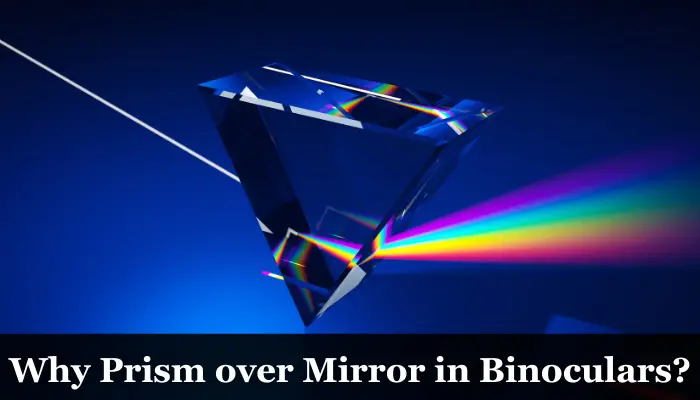This post may contain affiliate links which means I may receive a small commission for purchases made through the links. Learn More
The usage of prisms in the binoculars is common as they play a significant role in giving you correctly oriented images of the target. But have you ever noticed why manufacturers use mirrors instead of prisms to cut the prices of binoculars as mirrors are cheap?
But the primary question is: why are prisms used in binoculars? Actually, prisms are used in the binoculars to correct the orientation of the image. Objective lenses capture the light and send an inverted image to the prism. So, the prism works in a way to reorient the image.
Many times I hear this same question. Those people who don’t have technical information about the lenses find it confusing. But in today’s guide, I am going to debunk all the confusion by giving you the purposes of prisms, and why they are used instead of glasses.
Related Article: Who Makes Cabela Binoculars?
Why Are Prisms Used in Binoculars?
Prisms are the most important components of the binoculars which allow you to see the correct oriented images of the target through the barrels of the binoculars. If the manufacturer doesn’t use the prism, you will see an inverted image on the eyepiece of the binoculars.
First of all, the objective lens captures the light and makes an inverted image. In the end, this inverted image in the form of light goes to the prism. So, if there are no prisms in the binoculars, the inverted image will go to the eyepiece where you will end up seeing the wrong-sided image of the target.
So, to make the image correctly oriented, the manufacturers use the prisms. When the light from the objective lens comes to the prism, some internal reflections happen. As the result of that internal reflection happens on the prism, the image orientation gets corrected.
If there are no prisms, there won’t be any reflection of light, and there won’t be any image correction. Is that clear now? No matter if you use porro prism or roof prism, both act in a way that they correct the orientation of the image and send the perfectly right image to the eyepiece.
To give you some more explanation, prisms have two different types and I have already explained those types in my previous guides. I 100% suggest you read that guide and get your concepts strengthened about the roof and porro prisms.
Read Here: What Are Porro Prism Binoculars?
Read Here: What Are Roof Prism Binoculars?
I hope that you now understand the role of prism and why manufacturers use prism in binoculars. Let’s move to our next question, which is why do we use prisms instead of mirrors in binoculars.
Why Mirror is Not Used as a Prism in Binoculars?
This is an interesting question because it looks like we can use mirrors instead of prisms to reduce the prices of binoculars. In fact, when there were no prisms, the manufacturers used the mirror to produce the internal reflection so that the image orientation could be correct.
It is 100% true that a mirror is an inexpensive solution, but there are some practical issues that affect the performance of the binoculars if you use the mirror instead of prisms. In the section below, I am going to give you some reasons why mirrors are not an ideal replacement for prisms.
1- Light Absorption of Mirror
The mirrors absorb some light. When the objective sents the light to the prism, then the prism itself does not absorb the light and reflects maximum light (up to 99%). So, there is no loss of the light when we use the prism and the perfect light (image) goes to the eyepiece where the user gets the image.
But if we use a mirror instead of a prism, then it absorbs some amount of light. For example, when the objective sends light to the mirror, it will reflect up to 93 to 94 percent of the light and it will absorb up to 5 to 6 percent which is a big amount. The loss of this light in the form of absorption from the mirror affects the quality of the image.
Due to incomplete reflection, reduced light will go to the eyepiece which means that the users will see dim light, and compromised visuals. This is why manufacturers use prism instead of mirror as prism does not absorb light, and maximum reflection takes place.
2- Size and Weight
The mirror is usually heavier than the prism. If the manufacturer uses the mirror instead of the prism, then the binoculars would become too heavy which is a big issue, especially for those people who don’t like to carry heavier and bigger-sized binoculars. In the past, manufacturers used to use mirrors instead of prisms. This is why the old binoculars made decades ago are super heavier.
Point to Remember: If the manufacturer uses a mirror instead of a prism, there will be massive chromatic aberration, and the user won’t be able to see the image clearly. This is why a prism is preferred as it produces very little chromatic aberration which is controlled or overcome by using the phase coating on the prism.
Were Mirrors Used as Prisms in Binoculars?
Yes, mirrors were used in the binoculars in the past when there were no prisms. But those binoculars that consisted of mirrors were not ideal in terms of performance, as well as usability.
The usage of mirrors in the binoculars was one of the most prominent reasons that those binoculars were not excellent in giving brighter and sharper visuals. You keep in mind that the mirror absorbs light, so using them in the binoculars causes big issues related to optical performance.
Nowadays, no manufacturer uses mirrors and almost all modern binoculars come with prisms either Porro or roof. This is why one of the major reasons is that you get better visual quality with binoculars now. The phase coating on the prism further uplifts the visual quality as these coatings reduce the loss of light to a maximum level.
Usage of Mirror in Modern Binoculars
You should keep in mind that the mirror has played an important role in the functionality of the binoculars. The convex, and convex mirrors have always been an integral part of binoculars working. The objective lens is convex whereas the eyepiece uses the concave mirror to convert the light that is processed by the prism used in the binoculars.
These two mirrors are essential as without them, the existence of the binoculars would have been not possible. But we cannot use mirrors in place of prisms because mirrors do absorb some light which makes prisms the best option to be used in binoculars.
Conclusion
The usage of the prism is inevitable in binoculars. Almost all the modern binoculars come with prisms that reflect maximum light and you end up seeing brighter and sharper visuals. In the past, when prisms were not invented, mirrors were used. That’s why the older binoculars were heavier and offered compromised optical performance. I hope that this guide will prove to be a helping hand for you.

I’m a passionate outdoor activist who has got special love for optics. The school studies in optical mechanics and the travelling experience has made me an expert in optics like binoculars, scopes, and other devices. Stay connected with us for in-depth knowledge!

